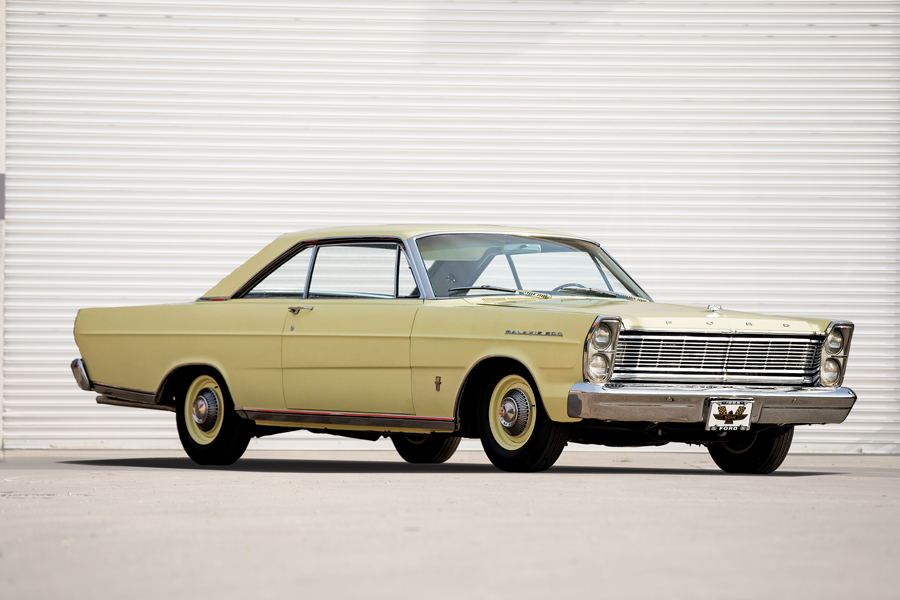- 427-ci SOHC M-code V8
- Dual Holley 4-barrel carburetors
- 657 hp at 6,000 rpm
- 4-speed manual transmission
- Factory experimental car
SCM Analysis
Detailing
| Vehicle: | 1965 Ford Galaxie 500 Cammer |
| Number Produced: | Unknown |
| SCM Valuation: | $110,000 (this car) |
| Tune Up Cost: | $300 (estimated) |
| Chassis Number Location: | Left inner fender/data tag in driver’s door jamb |
| Engine Number Location: | Block located at left rear just above oil pan |
| Alternatives: | 1969 Chevrolet Chevelle 427 COPO, 1966–67 Dodge Hemi Coronet/Charger, 1966–67 Plymouth Hemi Belvedere/Satellite |
| Investment Grade: | C |
This car, Lot 180, sold for $112,000, including buyer’s premium, at Bonhams’ Greenwich Concours d’Elegance auction in Greenwich, CT, on June 2, 2019.
While looking like any of the other 157,283 Galaxie 500 2-door hard tops built in 1965, this car is reportedly one of just a few built, and is likely the sole survivor. Why? Because it has the mighty M-code SOHC “Cammer” engine.
On the cam
In 1965, Ford’s “FE” big-block 427 was already well known. Introduced in 1963, it quickly dominated NASCAR circuits. However, facing MOPAR’s new 426 Hemi, Ford looked to improve the side-oiler.
Their answer: adapting the big block to a high-revving, two-valve, single-overhead-cam configuration.
Cost and development-time considerations meant a roller chain-cam drive was favored over geared units. The six-foot-long timing chain rotated a camshaft atop each head, which featured hemispherical combustion chambers.
The 90-day development effort paid off: With a single-barrel carb, the engine produced 616 hp at 7,000 rpm while producing 515 ft-lb of torque. Dual 4-barrels increased those numbers to 657 hp and 575 ft-lb. Ford planned to homologate the engine for NASCAR use. NASCAR promptly banned it.
No one knows how many Cammers were built, but estimates range from a few hundred to 2,000. Today the heads and intakes are produced by aftermarket firms. Most engines fell into the hands of top drag racers, where they found success.
A VIN and a story
The company tested these engines in a number of ’64–66 Galaxies, and serious consideration was given to making it an option in ’65 — indeed, the shop manual for the year lists it as an available engine. Ford announced the engine option in a 1966 news release, but no production cars were ever built.
The primary documentation of this car’s special status is its VIN number. The “F” shows it was built in Dearborn — presumably in Ford’s engineering facility. The “M” fifth digit identifies the engine as a Cammer.
Bonhams’ catalog presents the story in great detail: After initial testing, this Galaxie was reportedly sent to the experimental Ford shop at Watkins Glen, NY, where one of the employees, a “Mr. Henderson,” acquired it and took it home. After he drove it for a few years, it ended up in a field on the family farm.
About this time, its engine was removed by Henderson’s son, who replaced it with a common 390 and used it for racing. After Mr. Henderson died in 1980, the car passed to his daughter, who kept it hidden away. When she died in 1998, another brother got the car, which led to it being restored. Bonhams said “forensic research” determined the car’s original color and interior trim.
Along the way, the original data plate went missing and there is scant documentation on the car’s time at Ford or how it managed to escape the crusher — the usual fate of test cars.
So what we have is a car with a non-original motor, little documentation and with new paint and interior. The car fell well short of its pre-sale estimate of $300k–$400k.
The sum of its parts
No other factory cammers are known to exist. The best-documented cars were a pair of 1966 mules, which were well known in period and appeared in a few magazines. One was driven by a Ford special-vehicle exec, the other was loaned to astronaut “Gordo” Cooper. So what is this car worth?
In the realm of “one-of-one” Fords, the closest example is the ’67 Shelby GT500 “Super Snake,” which sold for $2.2 million in January (ACC# 6896510). But a Galaxie, even with a rare engine, is no Shelby.
Trying to compare apples to apples (so excluding various Pony cars and Corvettes) in terms of body style/size, ’66–71 mid-size Hemi Mopars, some of which have low production numbers, are a good match. They sell in the $80k–$200k price range. Likewise, the 99 ’69 Yenko Chevelles are powerful and rare, with a median value of $250k. These prices suggest Bonhams’ estimate wasn’t necessarily out of line, but this car’s originality and documentation issues held it back.
Compared to the cost of building a tribute, this M-code car was deservedly well sold. The same collection sold a nice ’66 7-Litre 428 “Q-code” Galaxie for $22,400 and an “R-code” 427/425 car for $32,480. They, or any ’65 Galaxie with a price-guide estimate of $20k–$30k, could be fitted with a period SOHC mill. Bonhams sold an engine at this auction for $38k; others have sold in the $50k range, meaning you could build a nice tribute for $60k–$90k.
With its lack of known history and originality issues, this car was appropriately sold, and as a unique bit of Ford history, well bought. But until a better documented car comes to market, the ultimate value of a factory street Cammer will remain a mystery.
(Introductory description courtesy of Bonhams.)
